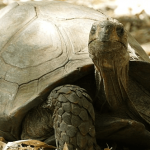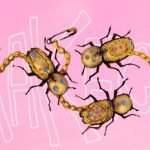 Mysteries
Mysteries  Mysteries
Mysteries  History
History 10 Surprising Stories About the Texas Rangers
 Humans
Humans 10 Philosophers Who Were Driven Mad by Their Own Theories
 Miscellaneous
Miscellaneous 10 Video-Game-Worthy Weapons and Armors from History
 Weird Stuff
Weird Stuff 10 Psychics Who Accurately Predicted Wartime Events
 The Arts
The Arts 10 Pieces of Art Inspired by a Broken Heart
 Health
Health 10 Science Fiction-Sounding New Medical Treatments
 History
History 10 Surprising Facts About the Father of Submarine Warfare
 Space
Space Ten Astonishing New Insights into Alien Worlds
 Weird Stuff
Weird Stuff 10 Bizarre Summer Solstice Rituals Still Practiced Today
 Mysteries
Mysteries Top 10 Haunting Facts About the Ghost Ship MV Alta
 History
History 10 Surprising Stories About the Texas Rangers
 Humans
Humans 10 Philosophers Who Were Driven Mad by Their Own Theories
Who's Behind Listverse?

Jamie Frater
Head Editor
Jamie founded Listverse due to an insatiable desire to share fascinating, obscure, and bizarre facts. He has been a guest speaker on numerous national radio and television stations and is a five time published author.
More About Us Miscellaneous
Miscellaneous 10 Video-Game-Worthy Weapons and Armors from History
 Weird Stuff
Weird Stuff 10 Psychics Who Accurately Predicted Wartime Events
 The Arts
The Arts 10 Pieces of Art Inspired by a Broken Heart
 Health
Health 10 Science Fiction-Sounding New Medical Treatments
 History
History 10 Surprising Facts About the Father of Submarine Warfare
 Space
Space Ten Astonishing New Insights into Alien Worlds
 Weird Stuff
Weird Stuff 10 Bizarre Summer Solstice Rituals Still Practiced Today
10 Prehistoric Creatures That Might Not Look How We Think
Like detectives solving a crime, scientists have to piece together clues from fossils, chemicals, and living relatives to build a picture of what prehistoric creatures looked like and how they behaved. Without witnesses to ask, it is no surprise that mistakes get made, but they can spread quickly due to the public’s interest in the subject.
Unfortunately, it can take years to dig up new evidence that contradicts an old idea. By this time, it has already captured the public’s imagination and made its way into pictures, sculptures, and movies. This list contains ten such cases where later research has suggested that commonly held ideas about well-known prehistoric creatures have been wrong.
Related: 10 Weird Critters That Lived Alongside the Dinosaurs
10 Megalodon Appearance
Earth’s oceans are full of mysterious and dangerous creatures, but one scary swimmer people can be thankful they do not have to worry about anymore is the megalodon. These were the ocean’s apex predators from 15–3.6 million years ago, and they were basically massive sharks that could grow up to 65 feet (20 meters) long. They have often been depicted as bulky beasts like modern great white sharks, as in The Meg movies with Jason Statham, but more recent research suggests that this is wrong.
No complete megalodon skeleton has ever been found, so scientists first used 3D modeling to predict the megalodon’s size and shape based on its fossilized teeth and vertebrae. This resulted in it looking like a giant great white.
However, a team of 26 shark experts published a paper in 2024 arguing that the vertebrae of the megalodon were so different from that of a great white that it could not have simply been a bigger version of the same animal. They believe it is more likely that the megalodon looked like the slimmer—but no less terrifying—mako shark.[1]
9 An Unexpected T-Rex Feature
It was certainly a large and lethal predator, but the famous Tyrannosaurus rex might not have looked quite as intimidating in reality as it did in movies like Jurassic Park. The reason for this is that they probably had lips that covered their terrifying teeth. Surprisingly, this idea is not new and has long been debated by experts. The dinosaurs were actually drawn this way in the 1920s and 1930s, but the idea of scary, spiky teeth sticking out like a crocodile’s captured the public’s imagination and dominated how the T. rex was depicted.
In 2023, new research was published that supported the idea that they had lips. Scientists studied the relationship between tooth size and skull size in living relatives of the T-Rex and similar dinosaurs, such as Komodo dragons. They found that their teeth were not so big that they needed to stick out of their mouth. The enamel on the surface of their teeth and their skull shape were also different from animals that expose their teeth, such as crocodiles. But, it was quite similar to lizards and iguanas—which both have lips.[2]
8 But Something T-Rex Didn’t Have
Here is one that the movies got right, but scientists did not… at least for a little while. The T. rex is usually depicted with scaly, lizard-like skin. But for a couple of decades, tyrannosaurus fossils kept being found, which bore evidence that the creatures had feathers like a bird. Although they continued to look the way they always had in most media, the scientific consensus was shifting toward a fluffy, feathered, and altogether less frightening—but no less deadly—tyrannosaur.
However, research published in 2017 supported Hollywood’s version of the T. rex over the scientists’ one. While there really were plenty of fossils that showed evidence of feathers, they had come from earlier, smaller tyrannosaurs. The 2017 research found that fossils from the later T. rex, along with most other large tyrannosaurs, did not show any indication that they had feathers.
Strangely, it seems like the T. rex evolved feathers and then lost them again later. This could have been to help them cool off after sprinting because large animals cannot cool down quickly like small ones.[3]
7 Pterodactyl Flight
Pterodactyls had wings supported by a fourth finger, just like bats do today. Although this sounds like a minor detail, it actually led to a longstanding error in the way these fascinating flyers have been shown in movies and illustrations. They are almost always shown flying the same way as bats do, with their legs apart and poking out behind them.
However, a 2018 study suggested that their ligaments would have likely stopped them from getting into such a pose. Soft tissues like ligaments are rarely preserved in fossils, and this can lead people to jump to conclusions based on the shape of the skeleton alone. But by manipulating the joints of the closest modern relatives of pterosaurs, birds (dead ones), scientists were able to map the range of motion that could be comfortably achieved.
In quail, they found that the bat-like pose could only happen if the bird’s ligament stretched 63% beyond its limit. In theory, pterodactyls should be subject to a similar limitation.[4]
6 Saber-Toothed Cats’ Teeth
Homotherium latidens was one of the most widespread species of saber-toothed cat. Appearing around 4 million years ago, the lion-sized predators spread across Africa, Eurasia, and South America before going extinct about 10,000 years ago. The skulls that have been found are similar to those of other saber-toothed species like the smilodon, with curved, razor-sharp canines that are significantly longer than the rest of the cat’s teeth.
Their 3-inch (7.6-centimeter) upper canines were double the length of a modern lion’s, and they were so deadly that a bite to the throat could cause an animal to pass out in mere seconds from the loss of blood. But while their skulls, like most illustrations of them, bear a certain similarity to the smilodon, their appearance while living might not have—unless they were threatening to strike. This is because they actually had room in their mouths to hide their teeth when they were not hunting, unlike the smilodon, whose 6-inch (15.2-centimeter) sabers were too long.[5]
5 Tiny Velociraptors
The velociraptor is probably just a fraction less famous than the tyrannosaurus, but unlike the latter it really did have feathers. Scaly skin is only one of the ways Hollywood, and notably the Jurassic Park series, got these wrong. There is little evidence that they hunted in packs; their claws were not really weapons and were likely used to pin prey down, and like modern predators, the majority of their hunting attempts probably failed.
But the most surprising fact about real raptors is that they were around the same size as a turkey. Big ones are seen in movies because another dinosaur of the Dromaeosaur family—to which velociraptors belong—was found in America. It was about the size of a large dog and was first thought to be a bigger velociraptor. By the time it was found to be a different species, the idea of a giant velociraptor had already spread.[6]
4 Diplodocus’s Head
These gentle giants are usually pictured chomping away at treetops like giraffes or with their heads upright in a swan-like posture. This is a reasonable assumption given their long necks, but it is one which has been disputed. In the 1990s, scientists measured the vertebrae in the neck of a Diplodocus skeleton and that of its cousin, the Apatosaurus, at the Carnegie Museum in Pittsburgh.
Once they had the measurements, they made computer models of the skeletons. These allowed them to simulate how the dinosaurs’ necks would have moved and map their range of motion. The models suggested that the Diplodocus could not have lifted its head much higher than its back. Rather than being a tall dinosaur, it was actually a very long one because its usual neck position would have been parallel to the ground. This makes it likely that they ate low vegetation, such as ferns, which also would have been more nutritious than treetop vegetation, like pine needles.[7]
3 Ginger Woolly Mammoths?
In artistic representations of woolly mammoths, as well as movies like the Ice Age series, their hair is usually shown to be an auburn or reddish-brown color, sometimes veering closer to orange. That is because this is the color of the preserved mammoth hairs that have been discovered so far. But it would be wrong to think that this was conclusive evidence as to their appearance.
Although the hairs were preserved, chemical reactions could have resulted in the color changing over time, or the pigment could have leached out. So, what color were the mammoths really? Using DNA extracted from a 43,000-year-old woolly mammoth bone found in Siberia, scientists were able to identify the gene that controlled the color of the mammoths’ coats.
It turns out that these enormous Arctic elephants came in three different colors—dark brown, pale ginger, and blond. Interestingly, the 2006 study that discovered this was the first time scientists had been able to learn about the appearance of an extinct species by studying its DNA.[8]
2 Dimetrodons Were Not a Drag
Pterodactyls are not the only prehistoric animals that might have moved differently than people assume based on their skeletons. They are probably more famous than the other—a pre-dinosaur predator called the Dimetrodon—whose shape is likely better known than its name.
The Dimetrodon has a body like a large lizard but with a unique, tall “sail” on its back, which is shaped a bit like a hand fan. Its body shape has long led to it being depicted as heavy and slow, moving with its legs sprawled out and its belly close to the ground. But this might not be the case. Fossilized footprints left by the beasts are narrow and show no evidence of belly-dragging.
In 2017, scientists used software to compare the Dimetrodon skeleton with living mammals and reptiles. The closest modern match for the Dimetrodon was the caiman. This crocodilian can extend its legs enough to lift its body and walk more like a four-legged mammal. It is thought that Dimetrodon might have moved in a similar way, which also could have made them faster.[9]
1 Mosasaur Shark-Like Tail
Another sea monster that has made it into the movies is the mosasaur, which was lurking beneath the surface of the sea some 98 to 66 million years before it appeared on screen in Jurassic World. Mosasaurs were shark-sized reptiles that could grow over 33 feet (10 meters) long, and being reptiles, they are usually imagined to look like large crocodilians with fins instead of legs and a long, lizard-like tail.
However, a well-preserved fossil found in the country of Jordan in 2008 had imprints that suggested the mosasaur had a powerful tail shaped more like a shark’s than a narrowing one like a reptile or an eel. This would potentially have allowed it to swim faster for longer and was something researchers had been pondering for several years before the evidence turned up.
Like some of the other examples on this list, the assumed shape of the tail was based on the fossilized bone only. The early scholars had not considered that if the soft tissue had been preserved as well then it might tell a different story.[10]








